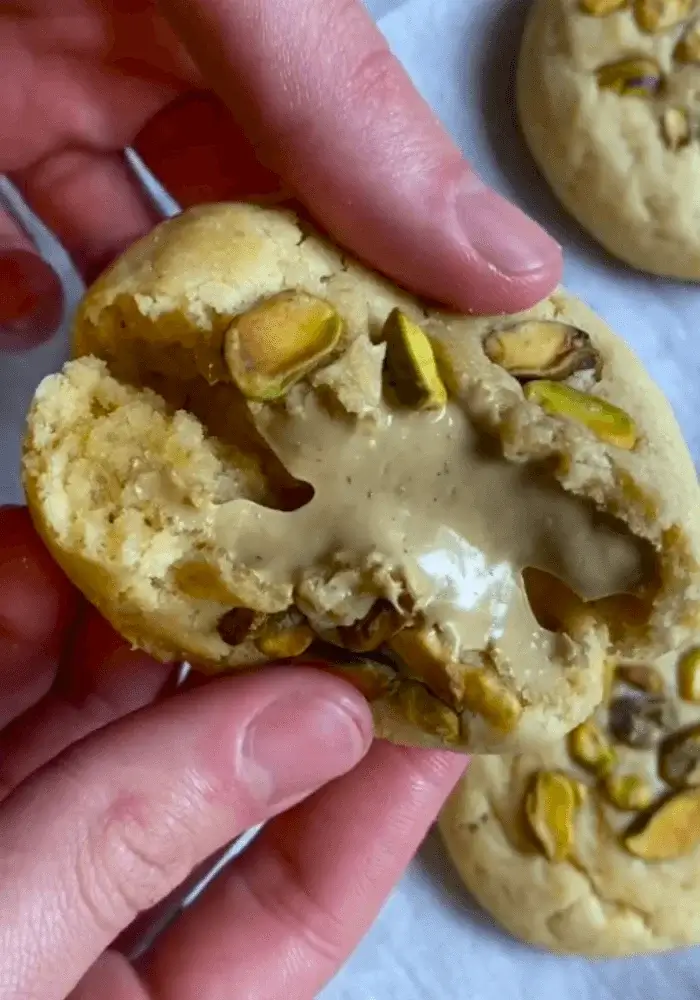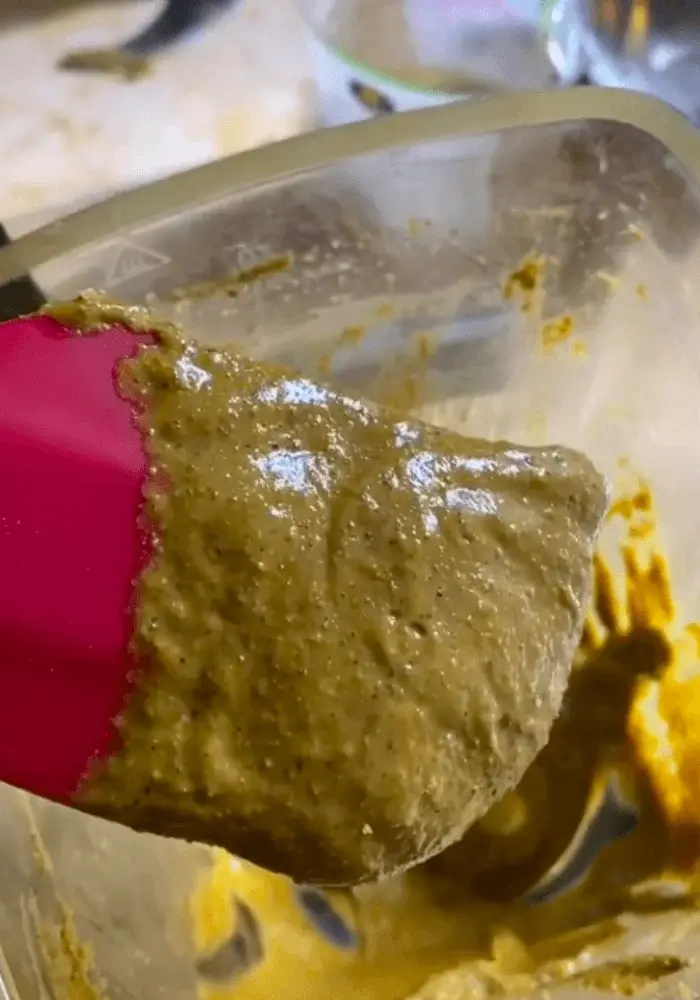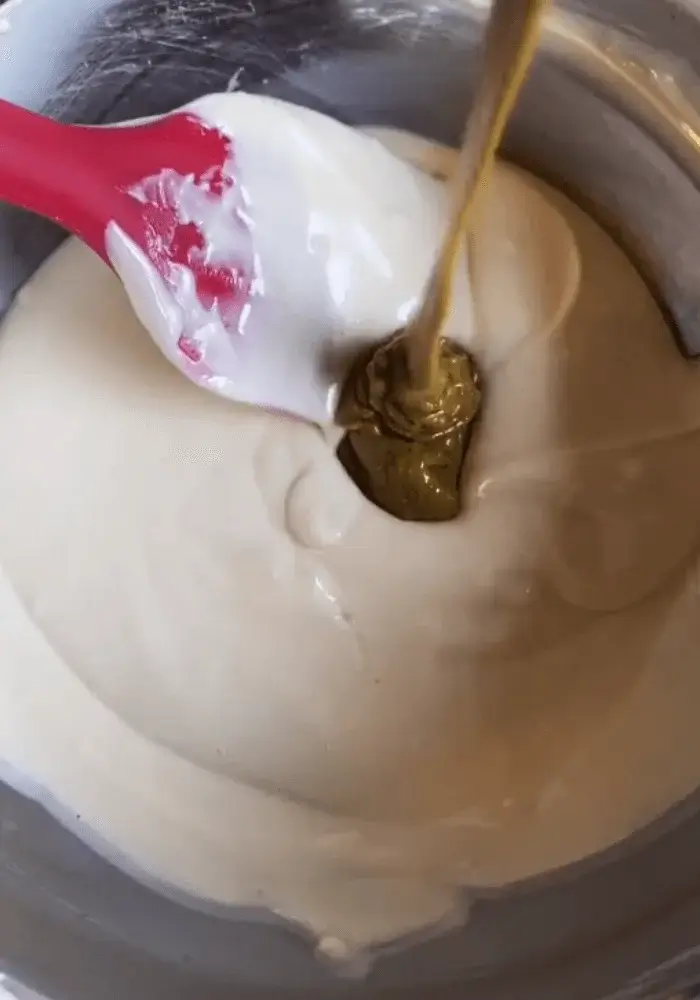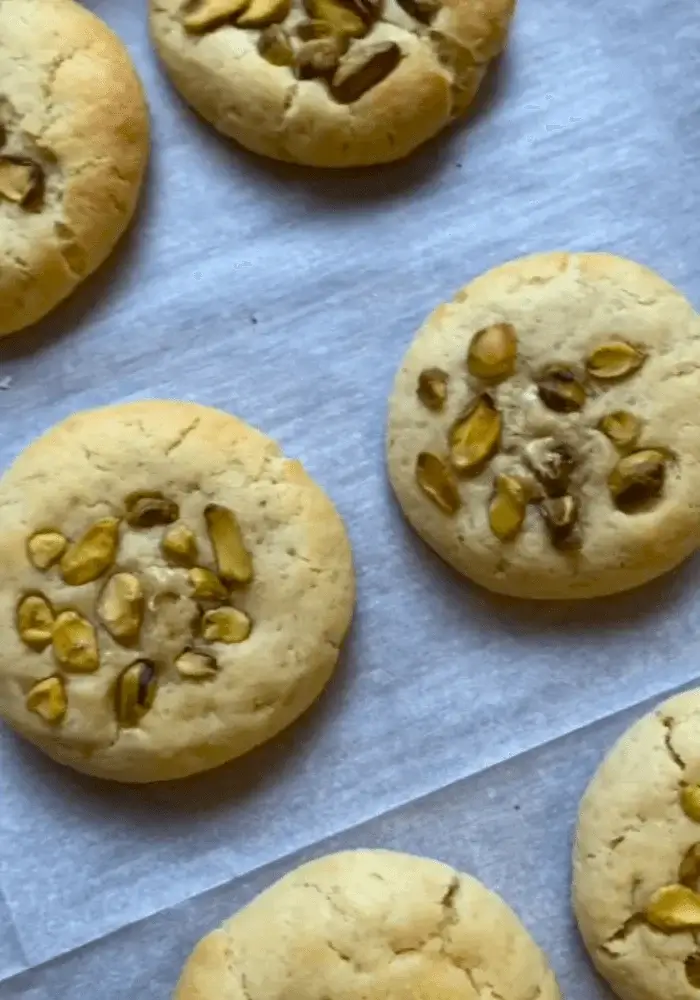Soft-Baked White Chocolate Pistachio Cookies
We may earn a commission from recommended products, at no extra cost to you. See Disclosure.
- Baking sheet
- Semi sphere silicone molds
INGREDIENTS
- 1/2 cup/100 grams sugar
- 1/2 cup/100 grams light brown sugar
- 1 cup/250 grams unsalted butter, at room temperature
- 2 large eggs
- 3 3/4 cups/500 grams all-purpose flour
- 1 1/2 teaspoons/6 grams baking soda
- 1/2 teaspoon salt
Filling:
- 2 cups/350 grams white chocolate, finely chopped
- 3 tablespoons/50 grams pistachio paste
INSTRUCTIONS
- In a large bowl, using a hand mixer or stand mixer, beat the white sugar, brown sugar, and eggs on medium speed until pale and thick, about 2 minutes. Add the butter and beat until smooth. Add the flour, baking soda, and salt, and mix on low speed just until the dough comes together. Cover and refrigerate for 30 minutes.
- Place the white chocolate in a microwave-safe bowl and melt in 20-second intervals, stirring between each, until smooth. Stir in the pistachio purée until fully combined. Spoon the mixture into silicone molds or onto a parchment-lined tray in 1-teaspoon mounds. Freeze until solid, about 1 hour.
- Heat the oven to 355°F/180°C. Line a baking sheet with parchment paper.
- Scoop about 2 tablespoons of dough and flatten it into a disc. Place a frozen pistachio-white chocolate center in the middle and top with another piece of flattened dough. Pinch the edges to seal, then roll gently into a ball. Repeat with the remaining dough and filling.
- Arrange the cookies on the baking sheet, spacing them 2 inches apart. Bake until the edges are lightly golden and the centers are just set, about 9 minutes. Let cool on the baking sheet for 5 minutes, then transfer to a wire rack to cool completely.

FAQ
How can I make these white chocolate pistachio cookies gluten-free?
Substitute the all-purpose flour with a gluten-free flour blend that includes a binder such as xanthan gum. Avoid using single flours like almond or coconut flour, which lack the structure needed for cookies. Choose a 1:1 gluten-free baking mix designed for cookies to ensure the dough holds together well and doesn’t spread excessively during baking. You may need to chill the dough slightly longer, as gluten-free versions tend to be more delicate. Bake time remains the same, but monitor closely, as some gluten-free blends brown faster. The filling and method remain unchanged.
What can I substitue the eggs with?
Good options include 1/4 cup unsweetened applesauce or 1 tablespoon ground flaxseed mixed with 3 tablespoons water per egg. These alternatives help hold the dough together, though the texture may be slightly softer or cakier than the original version. Chill the dough thoroughly to make it easier to handle and shape around the frozen filling. Because this dough is rich in butter, the fat content will still help provide structure and flavor, even without eggs.

How do I keep the filling from leaking out during baking?
Make sure the filling mixture is fully frozen and firm before using. When shaping the cookies, use enough dough to encase the filling completely and seal all edges tightly. Flattening the dough discs slightly before sealing helps avoid air pockets that can rupture during baking. Chilling the shaped cookies for 10 minutes before baking can also help the dough hold its shape better in the oven. Don’t overbake; if the dough becomes too dry, it’s more likely to crack and expose the soft center.
Can I freeze the white chocolate pistachio cookies before or after baking?
These white chocolate pistachio cookies freeze well both before and after baking. To freeze before baking, shape the filled dough into balls and place them on a baking sheet until firm, then transfer to a freezer bag. Bake directly from frozen, adding 1 to 2 minutes to the baking time. To freeze after baking, let the cookies cool completely, then place in an airtight container or freezer-safe bag. Defrost at room temperature or warm briefly in a low oven. Freezing after baking may slightly affect the texture, but the filling stays creamy and flavorful.
Do the cookies stay soft after they cool?
Yes, especially when stored properly. The high butter content in the dough and the gooey center from the pistachio-white chocolate filling help maintain a tender texture for several days. Let the cookies cool on a rack after baking to avoid sogginess. Once fully cooled, store them in an airtight container at room temperature for up to 3 days. If you prefer them warm, you can reheat each cookie for 5 to 10 seconds in the microwave to slightly soften the center without drying out the edges.

Can I make the dough in advance and refrigerate it overnight?
Chilling the dough for several hours or overnight helps deepen the flavor and improves texture by allowing the flour to fully hydrate. Before using, let the dough sit at room temperature for about 10 to 15 minutes so it’s easier to work with when shaping and filling. If it feels too firm, knead it briefly by hand. The frozen pistachio-white chocolate centers can also be made in advance and stored in the freezer until ready to assemble and bake.
What to do if I don’t have these silicone molds for freezing?
You can still make this white chocolate pistachio cookies recipe by lining a baking sheet or plate with parchment paper, drop 1-teaspoon mounds of the filling onto it, and freeze until solid. Once frozen, they can be handled and placed into the cookie dough as usual.
Can I add other flavorings to the dough?
You can customize the dough for white chocolate pistachio cookies with subtle flavor additions. A teaspoon of vanilla extract enhances the buttery base, while a touch of almond extract complements the pistachio notes. For something more aromatic, try adding finely grated orange or lemon zest to the dough. Avoid overpowering flavors like mint or cinnamon, which may clash with the nutty-sweet balance of the filling.
How can I make white chocolate pistachio cookies without a mixer?
Use a sturdy whisk or wooden spoon to beat the sugars and eggs until pale and smooth, then stir in the softened butter until well blended. Gradually incorporate the dry ingredients with a spatula or your hands, being careful not to overmix. The dough may be slightly stiffer by hand, so allow a few extra minutes of mixing to ensure it’s evenly combined.

